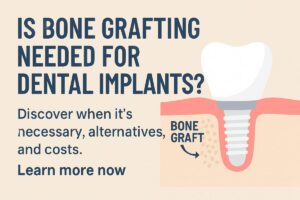Are you asking, “Is a full implant the right choice for you?” This article walks through the full implant choice so you can quickly decide if a full-arch implant is worth exploring. Read the short sections below to learn what a full implant is, who is a good candidate, the pros and cons, and the next steps if you want to move forward.
What Is a Full Implant?
A full implant, or full-arch implant, replaces an entire row of upper or lower teeth using several dental implants to support a fixed set of teeth. Common types include All-on-4, implant-supported dentures, and fixed hybrid prostheses.
Unlike a single-tooth implant that replaces one tooth, a full implant restores a whole arch. It is usually fixed in place and feels more like natural teeth. It is different from removable dentures because the prosthesis is anchored to implants and does not slip or need daily removal.
Who Makes a Good Candidate for a Full Implant?
Not everyone needs or should get a full-arch restoration. A good candidate typically meets several health and dental criteria:
- Many missing or failing teeth across an arch
- Enough jawbone volume or willingness to have bone grafting if needed
- Healthy gums or treatable gum disease
- Reasonable overall health (no uncontrolled diabetes, for example)
- Non-smoker or willing to quit, since smoking affects healing
Necessary tests and evaluations
Before deciding, your dentist will order tests and do an exam. Typical evaluations include:
- CBCT (3D X-ray) to check bone structure
- Full dental exam and periodontal assessment
- Medical history review to spot conditions that affect surgery
- Assessment for possible bone grafting or sinus lift
Pros and Cons to Consider When Weighing a Full Implant Choice
Weigh the advantages and disadvantages to see if the full implant choice fits your goals.
- Benefits: Better chewing and speech, bone preservation, long-term stability, and a natural look and feel.
- Drawbacks: Higher upfront cost, surgical risks like infection or implant failure, longer timeline from planning to final teeth, and ongoing maintenance needs.
Cost, timeline, and expected recovery
Cost depends on the number of implants, materials, and need for grafts. Treatment usually follows stages: consultation and imaging, implant surgery, healing (osseointegration), and delivery of the final prosthesis. Healing can take a few months, though many patients receive a temporary prosthesis the same day or soon after surgery to restore function while healing continues.
Expect soreness and swelling for a few days to weeks. Full recovery and final restorations typically take several months, depending on individual healing and any additional procedures.
How to Decide Next: Questions to Ask and Next Steps
In a consultation, ask focused questions to judge the provider and the plan. Useful questions include:
- How many full-arch cases have you done?
- What are your complication and success rates?
- Will you use guided surgery or digital planning?
- What are my options for temporary and final prostheses?
- What financing or payment plans do you offer?
Consider getting a second opinion if anything feels unclear. Compare treatment plans, timelines, and costs. Look for clear before-and-after examples and patient reviews focused on full-arch work.
We have experience treating full-arch patients and can explain treatment steps, expected outcomes, and financing options during a consultation. If you want to explore the full implant choice further, schedule a visit to review your scans and get a personalized plan.




